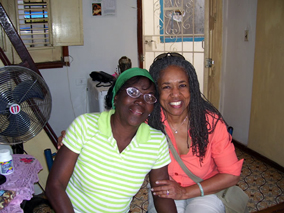Growing Old in Cuba: A Preliminary Look
- Submitted by: admin
- Society
- Personalities
- 04 / 22 / 2010

“¿Cuba? ... es muy complicado,” says our new Cuban acquaintance. Cuba? ... is very complicated. And growing old in Cuba can be complicated even more so by the infirmities of age.
During our one-week stay in Cuba I was able to meet with a 72-year old active woman who shared with me all of the programs that are available in Havana through state-run aging services.
I was also able to visit an apartment building that was under renovation for “senior housing.” Also, I was able to interview a professor of psychology at the University of Havana who gave me more information and more contacts for future visits.
My first impression of the older people walking on the street was their vigor. I noticed very little severe osteoporosis among the women, although there were some with obviously collapsed vertebrae, producing the telltale “widow’s hump.”
The current housing crisis in Cuba defines relationships among generations. A first generation of post-revolutionary parents acquired a small apartment shortly after the revolution. Because of the deteriorated condition of much of the housing stock
in Havana, multiple generations continue to live in the original apartments, causing no end of difficulties for families.
I was introduced to 72-year-old Flora by her daughter Elba. They are both professional women; Flora is retired and Elba is the director of the laboratory at a local women’s hospital.
They live in a less than-500-square foot flat in central Havana.They have constructed a loft that utilizes the high ceilings to provide another level, almost doubling their space.
The loft provides a sleeping area. They are fortunate because they have running water and a toilet.
According to Flora, there is a housing shortage, so there is no housing specifically designed for healthy older adults. But activities for active seniors are available. Flora has been trained to do daily exercises, first in the bed, then chair exercises in the room downstairs, then yoga breathing at the window.
Flora, like almost everyone else, depended upon walking or public transportation to get around Havana. She walks to the library where her classes are scheduled several days per week. Classes include psychology, dance, music and others.
She goes with a senior group on excursions throughout the country. She is a fabled cook and at one time left Cuba for a short stay in Italy as the cook for the family of an Italian businessman.
My next discussions took place at a facility that housed long-term care beds and an adult daycare center. I was allowed neither to take photos nor to tape discussions. However, I had a long talk with the social worker at the facility. who first sat down and answered my questions, then took me on a tour of the senior facility.
The facility was under restoration. There are 47 participants currently taking part in the two programs that are offered: long-term care residency and adult day care.
For the daycare program, individuals are dropped off in the morning while family members work during the day. These participants return home to their families in the evening.
They become eligible to participate in the program when they cannot perform several of the “activities of daily living,” but do not require nursing care.
Residents in the long-term care program have lost the ability to perform all of the activities of daily living. They live on the premises and are provided 24-hour care.
The residence that I toured had eight floors. Only two were restored. There are 12 rooms available for daycare residents; each has his or her own bed in a gender-separated room of two to four residents.
By Mary Watson
Source: http://fourstory.org/features/story/
Comments